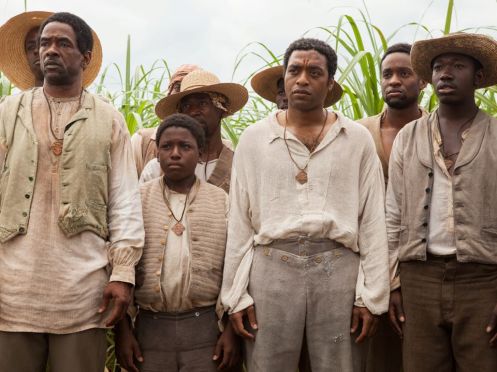Review: 12 Years a Slave
Every few years, a historical film will arrive whose impact is so unshakable that it becomes essential viewing to understand the period that it represents. Films like Alain Resnais’ Night and Fog, Elem Klimov’s Come and See, and Paul Greengrass’ United 93 are all masterworks and yet are so horrific that one would be hard pressed to ever want to watch them again. The topic of slavery has certainly haunted America’s legacy, and yet too many films have politely danced around the topic without looking at it straight on. Steve McQueen, a British director known for not shying away from harsh subject matter takes the task of that portrayal readily, and he proves to be an immaculate fit. With his third feature, 12 Years a Slave, McQueen delivers an unsparing portrait of America’s darkest hour, coming as close to a living document of the time as cinema can offer.
12 Years a Slave is based on the memoirs of Solomon Northup, a free black man who lived a comfortable life with his family in Saratoga, New York in the 1840’s. A professional player of the violin, Northup (Chiwetel Ejiofor) plays at various events populated by whites, but never has to think twice about the color of his skin. It’s a surreal scene of serenity before the film takes its sharp turn into darkness. When approached by two men to perform at a circus in Washington, D.C. for a handsome sum, Northup avidly agrees. That night, he falls sick after having too much to drink and when he awakens, he finds himself in a cell, his arms and legs chained. When he protests his freedom, Solomon is thrown to the ground on his stomach and viciously struck with a wooden paddle. Given the name of Platt, he is then taken on a ship to New Orleans, at the mercy of men willing to sell human flesh like cattle. Thus begins his nightmarish twelve years of brutal servitude.
Over the course of his enslavement, Northup is passed through several masters, all of whom have varying approaches of care (or lack thereof) toward their slaves. William Ford (Benedict Cumberbatch) is his first master, a benevolent preacher who provides as much comfort as is likely possible under the circumstances, but when Northup comes into conflict with harsher fellow master John Tibeats (Paul Dano), Northup finds himself passed on to Edwin Epps (Michael Fassbender), a true terrorist who believes in his divine right as a slave owner. Because of his educated background, Solomon learns that the less he reveals the better, for he is otherwise a threat. Each member of this cast is entirely committed, even small supporting roles from familiar faces like Paul Giamatti and Brad Pitt. Though there are certainly standouts, none are for the sake of showboating, for they are all part of the larger fabric that McQueen is intent on stitching. Ejiofor, a longtime character actor, gets his moment in the unrelenting sun, a deeply soulful portrayal of survival that acts as an avatar for the audience. Fassbender is as magnetic and commanding as he’s ever been, and the new face of Lupita Nyong’o plays Patsy, his prized slave, a young woman completely robbed of her humanity. It is in Patsy’s emaciated face that we see the wounds of slavery extend much deeper than her shockingly scarred back.
As with his previous features, 12 Years a Slave is constructed with a partial formality by McQueen and his collaborators. In dozens of scenes, McQueen and his cinematographer allow the camera to simply sit and observe, at times at a distance and other times in closeup. This is as close to documentary filmmaking as McQueen will accomplish with the material, and so his occasional restraint with editing keeps the audience from breaking with the moment. However, that does not mean that McQueen doesn’t know the power of cutting either. At several moments of peak intensity, 12 Years a Slave makes sudden cuts, emphasizing the abruptness of Solomon’s situation and the random violence he and others endure. If there is a flaw to the editing or overall structure of the film, its that the passage of time isn’t quite effectively communicated. Yes, the length of Northup’s ordeal is there in the title, but its hard to get a feel for it. Part of this may have to do with the consistent climate of the Louisiana location, but the passage of time is only fully communicated at the film’s quietly devastating conclusion. Other textural elements from the production design and costumes may feel taken for granted given the number of films made taking place in the 1800s, but they nevertheless contribute to the sweat soaked atmosphere. Hans Zimmers largely restrained score offers only a few moments of external emotion as McQueen’s films are the furthest thing from sentimental, and the same goes for 12 Years a Slave. Zimmer’s score is curiously one of his weaker efforts, too often evoking parts of his Inception cues, and only occasionally offering moments of bombast as when Northup is taken to New Orleans.
On the whole, 12 Years a Slave is a major benchmark both for McQueen and for the depiction of slavery in all forms of art, cinema or otherwise. For all of its exceptional finesse in front of and behind the lens, its greatest achievement is its ability to give the audience the perception of experiencing slavery firsthand. With that experience comes genuine disgust and shock, but even more disturbingly, near resignation. Indeed, 12 Years a Slave shows with remarkable dispassion and assured focus that the true horror of slavery was not its brutality or inhumanity, but its acceptance.

